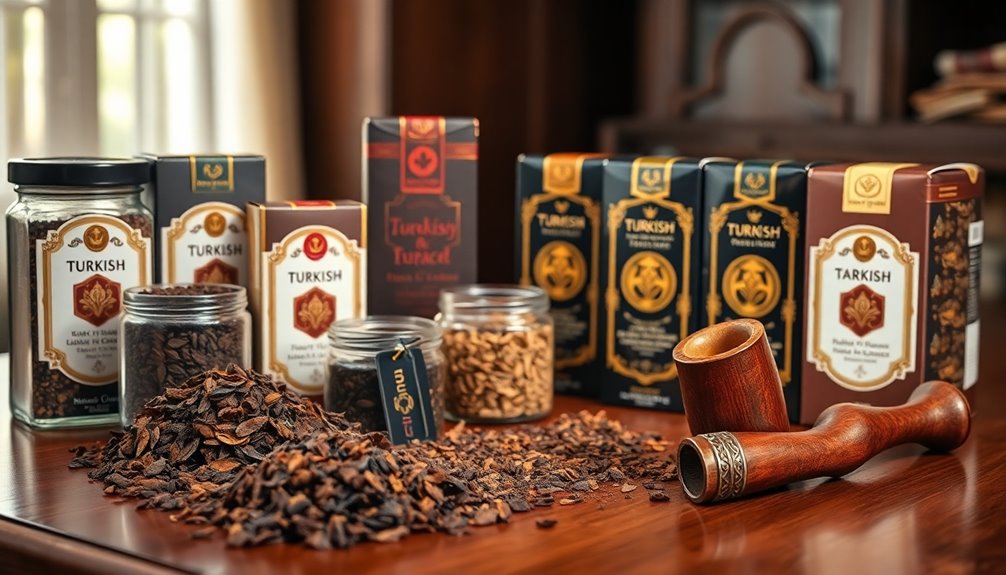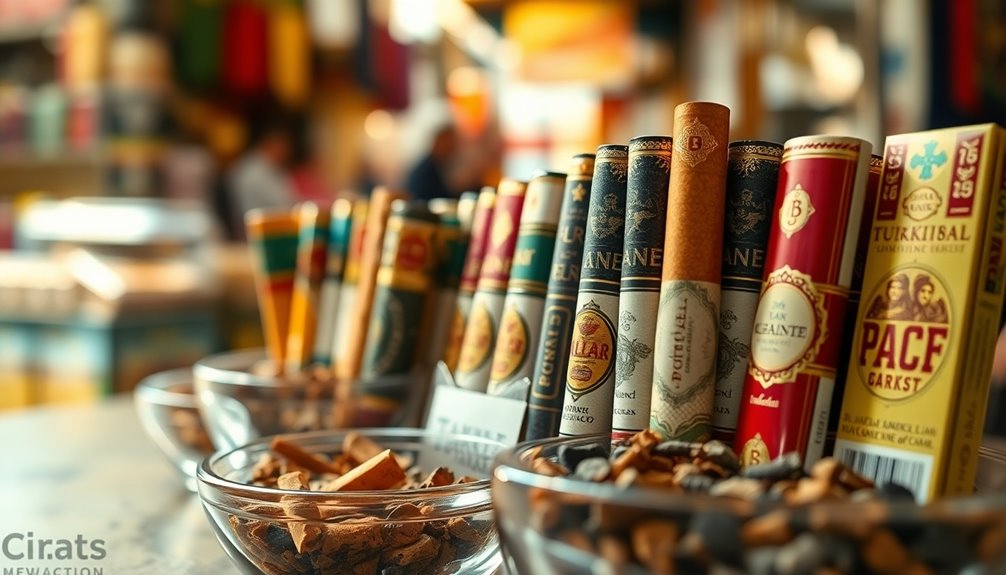Fatima Turkish Cigarettes blend tradition and quality in a remarkable way. Originating in the 1870s, these cigarettes are crafted from aromatic Oriental tobaccos like Xanthi, Basma, and Yenidje. You'll appreciate the sun-curing method, which enhances both flavor and color. Initially targeting educated consumers, Fatima grew in popularity, especially between 1910 and 1920. While it faced challenges during the Great Depression and eventual decline, its legacy in tobacco history is undeniable. If you're curious about how this unique brand evolved and its impact on culture, there's plenty more to discover.
Key Takeaways
- Fatima Cigarettes, established in the 1870s, are renowned for their exotic blend of quality Turkish tobaccos, embodying tradition and craftsmanship.
- The brand's unique flavor profile includes herbal and earthy notes, achieved through careful sun-curing and blending of Oriental tobaccos.
- Their manufacturing process revolutionized cigarette production, utilizing machines that could produce up to 20,000 cigarettes per minute with strict quality controls.
- Fatima's packaging and branding, featuring orientalist themes, targeted educated consumers, contributing to its cultural impact in the early 20th century.
- Despite declining sales and eventual discontinuation in the 1980s, Fatima Cigarettes remain a significant part of tobacco history and heritage.
Historical Background of Fatima Cigarettes
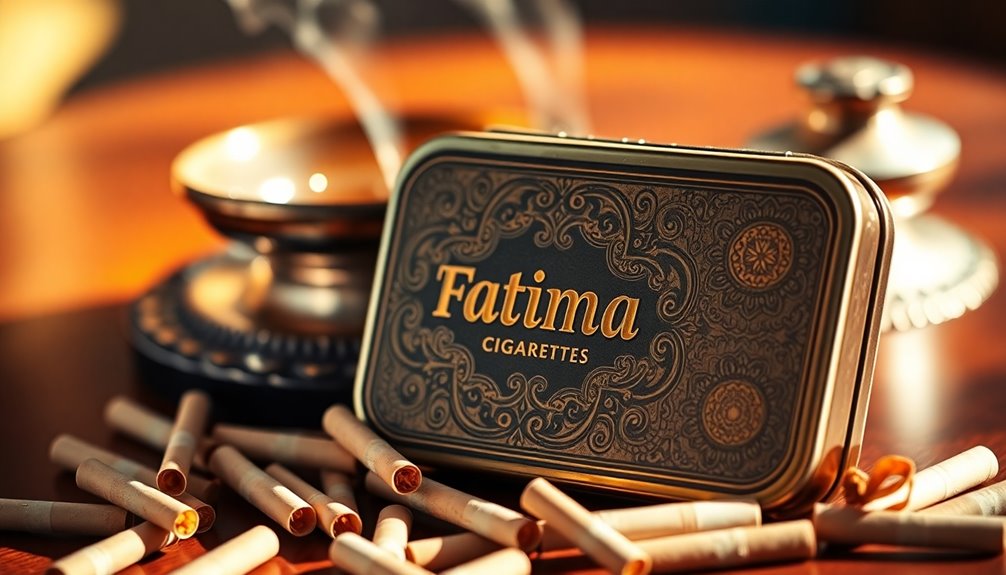
Fatima cigarettes emerged in the 1870s, marking a significant moment in the tobacco industry. Manufactured by the Liggett & Myers tobacco company, these cigarettes were marketed as an exotic blend of Turkish tobaccos. Their name, Fatima, drew inspiration from a common Turkish or Arabic woman's name, evoking a sense of mystique and allure. Notably, they were among the first brands produced using a cigarette machine, revolutionizing the manufacturing process.
By the early 1900s, Fatima cigarettes became legitimate competitors to leading brands, tripling sales alongside other Turkish and Egyptian cigarette varieties. They achieved remarkable popularity, becoming the best-selling cigarette brand in the U.S. from 1910 to 1920, with packs priced at just 15 cents around 1911. The brand's visibility soared, with displays in tobacco stands within the Capitol building in Washington, D.C. Furthermore, the brand's rise can be paralleled with the significant religious pilgrimage associated with the town of Fatima, which also gained prominence during this time.
Fatima's packaging featured captivating art, including a veiled woman and symbols associated with the Ottoman Empire. Their strategic advertising targeted educated, prosperous consumers, establishing a cultural presence that resonated with various social classes.
This historical backdrop laid the foundation for Fatima's enduring legacy in the tobacco market.
Evolution of the Brand
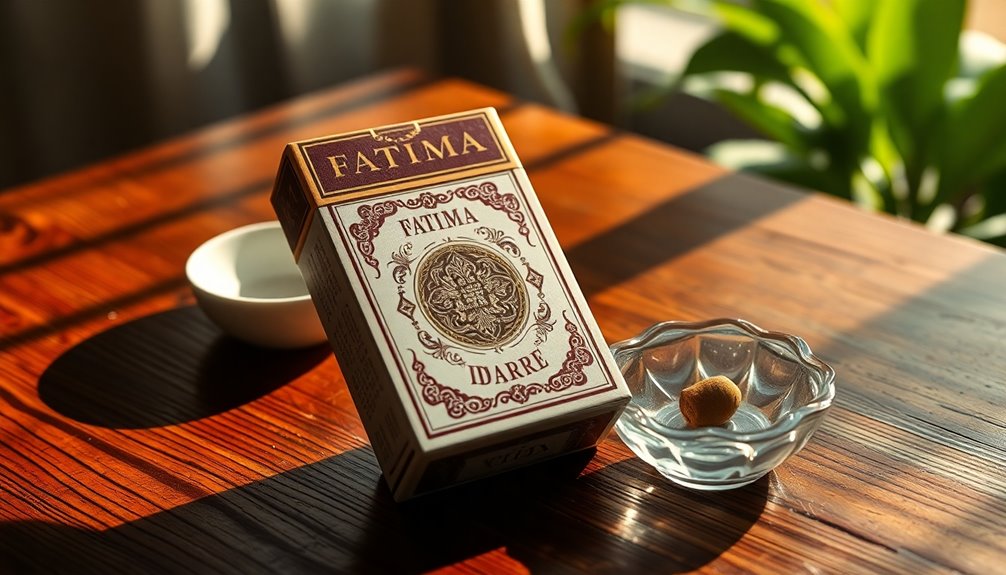
Over the decades, the evolution of the Fatima brand reflects its adaptation to changing market dynamics and consumer preferences. Introduced in the 1870s, Fatima initially captured attention with packaging that showcased Turkish tobaccos and the image of a veiled Middle Eastern woman. The brand targeted educated and prosperous consumers, positioning itself as "Distinctively individual" for elegant occasions. Premium offers, like cigarette cards featuring American university flags, attracted a diverse smoker base.
However, the Great Depression led to a halt in advertising, causing sales to plummet. In the late 1940s, Fatima attempted a comeback, focusing on radio campaigns, which included sponsorship of the *Dragnet* series and *Tales of Fatima*. Despite these efforts, the brand's old-fashioned image hindered its appeal, contributing to a decline in market share from the mid-1950s onward. During its peak, Fatima was also notable for being one of the first brands to utilize a cigarette machine in its production, enhancing efficiency.
While Fatima underwent modernization after World War II, it ultimately struggled to regain its foothold. The failure to adapt to evolving consumer preferences and increased competition led to its phased-out discontinuation by Liggett & Myers in the 1980s, marking the end of a storied brand.
Unique Tobacco Blend Characteristics
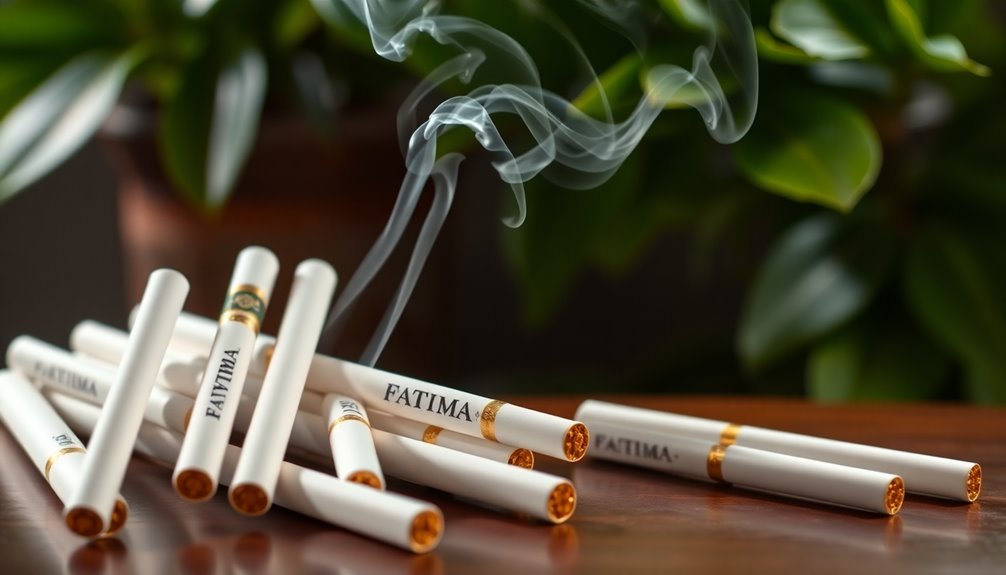
The unique tobacco blend characteristics of Fatima cigarettes are what set them apart in the market. You'll notice an aromatic flavor profile, marked by herbal and earthy notes with sweet and piquant undertones. This blend is often described as having a sharp, distinct aroma that's both recognizable and memorable.
While some might say the room note resembles stale flatulence, it's exactly this distinctive quality that appeals to loyal smokers.
The tobacco used in Fatima cigarettes comes from various Oriental types like Xanthi, Basma, and Yenidje, each contributing its own unique flavor derived from the soil and air quality of the regions they're grown in. Lighter varieties, like Izmir, offer a milder taste, while the richer Turkish tobaccos, such as those from Yenice and Drama, provide a fuller experience when blended with Virginian and Burley tobaccos. Oriental tobaccos are often used as a condiment or spice, enhancing the overall complexity of the blend.
Sun-curing, the prevalent method for preparing these leaves, enhances the tobacco's color and flavor. With its historical roots in the Ottoman Empire, Turkish tobacco remains a significant player in the world, making Fatima cigarettes a true representation of quality and tradition.
Manufacturing Process Overview

In crafting Fatima cigarettes, manufacturers follow a meticulous process that transforms raw tobacco into a finished product.
It starts with harvesting tobacco leaves, which undergo different drying methods based on their type. Oriental tobacco is traditionally sun-cured or dried in plastic-covered tunnels, while bright tobacco gets cured in bulk barns for 5-7 days, achieving its signature golden color. Burley tobacco is handled differently; the entire stalk is cut, hung, and then the leaves are hand-stripped and graded.
Once dried, the leaves are finely cut and moisture levels are carefully adjusted using a drying cylinder. This preparation is crucial before entering the manufacturing phase.
The manufacturing process begins with creating a long cigarette rod by placing a line of tobacco on a spool of paper, which is then wrapped and sliced into shorter pieces. Filters are inserted at both ends, and tipping paper connects them to form the cigarettes.
Machines can produce up to 20,000 cigarettes per minute, ensuring consistency.
After production, individual cigarettes are sorted, wrapped in foil for freshness, and packaged into cartons, all under strict quality assurance to ensure a high standard at every stage of the process.
Cultural Impact and Market Presence
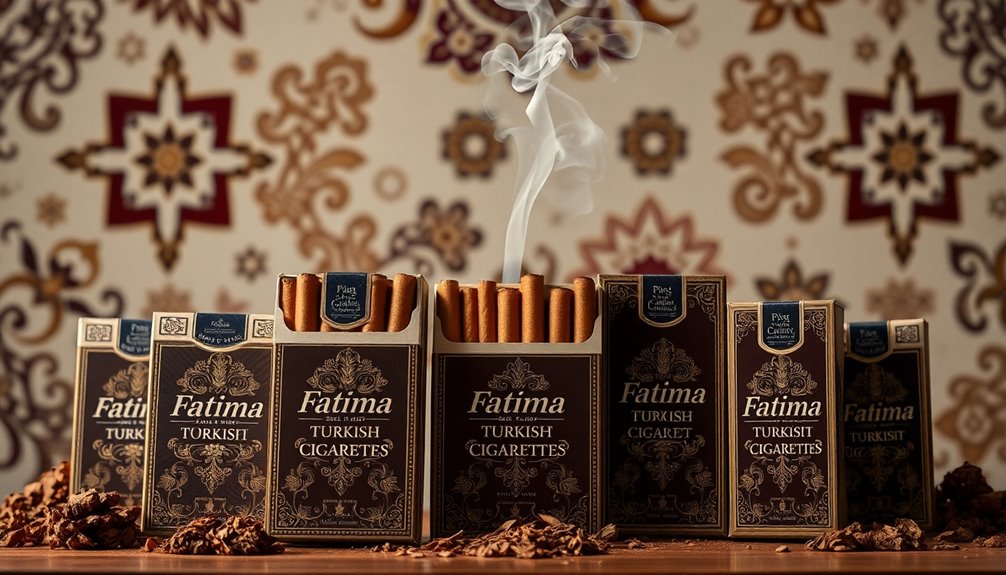
Fatima's cultural impact and market presence reflect a unique blend of exoticism and strategic branding that captivated consumers in the early 20th century. The brand's packaging featured a veiled Middle Eastern woman and symbols like the Turkish crescent moon and the Ottoman empire emblem, tapping into the orientalist themes prevalent at the time. Naming the cigarettes after a common Arabic woman's name further reinforced the Turkish image, enticing consumers with an exotic allure.
Launched in the 1870s, Fatima quickly became one of the first brands made using a cigarette machine, dominating the U.S. market from 1910 to 1920. Their advertising strategies targeted soldiers and educated consumers, utilizing diverse media, including radio campaigns and premium offers.
However, by the late 1920s, the Turkish fad waned, and competition from brands like Camel siphoned off market share. Despite innovative packaging and a king-sized version in the late 1940s, Fatima struggled to regain its footing after World War I.
Ultimately, Liggett & Myers phased out the brand in the 1980s as it failed to adapt to changing consumer preferences and intensifying competition. The legacy of Fatima Turkish Cigarettes remains a fascinating chapter in tobacco history.
Frequently Asked Questions
Are Fatima Cigarettes Still Available for Purchase Today?
Fatima cigarettes aren't available for purchase today. They were phased out in the 1980s and no longer compete in the market.
While you won't find them in stores, you can explore vintage and collectible items related to the brand on platforms like Etsy and auction sites.
These items, including signs and match holders, offer a glimpse into the brand's history, allowing you to appreciate its legacy without purchasing the cigarettes themselves.
What Are the Health Risks Associated With Smoking Fatima Cigarettes?
Smoking cigarettes, including Fatima cigarettes, poses significant health risks. You increase your chances of developing lung cancer, heart disease, and chronic respiratory issues with each puff.
The harmful chemicals in cigarette smoke can damage nearly every organ in your body. Additionally, secondhand smoke endangers those around you, leading to serious health consequences for nonsmokers.
Quitting smoking can greatly reduce these risks, improving your overall health and well-being.
How Do Fatima Cigarettes Compare to Other Brands in Taste?
When you compare Fatima cigarettes to other brands, you'll notice a distinct taste profile.
Fatima's unique blend of Turkish tobacco offers a tea-like, sour, and spicy flavor that's different from the more common smoky notes found in many American brands.
While brands like Camel might emphasize a stronger, bolder taste, Fatima's smooth and herbal notes cater to those seeking something more refined and exotic in their smoking experience.
What Is the Nicotine Content of Fatima Turkish Cigarettes?
You won't find specific nicotine content data for Fatima Turkish cigarettes, as detailed figures just aren't available.
Generally, nicotine yields in cigarettes range from 0.3 to 2.6 mg, but Fatima's exact numbers haven't been documented.
Over the years, nicotine content likely varied due to changes in manufacturing and regulations.
If you're curious about the brand's historical context, keep in mind that the nicotine content wasn't typically highlighted during its peak popularity.
Can I Find Fatima Cigarettes in Different Flavors?
You won't find Fatima cigarettes in different flavors.
Historically, they focused on a unique Turkish tobacco blend, and that's what defined the brand. Even after updates post-World War II, they stuck to their original flavor profile without introducing new variations.
If you're looking for something beyond that traditional taste, you might want to explore other brands that offer a variety of flavors.
Fatima's legacy remains tied to its singular, distinct Turkish blend.
Conclusion
In conclusion, Fatima Turkish cigarettes represent a rich tapestry of tradition and quality that's hard to find elsewhere. With a unique blend of tobaccos and a meticulous manufacturing process, you're not just smoking a cigarette; you're experiencing a piece of history. Their cultural significance and enduring market presence further solidify their status as a beloved choice among smokers. So, whether you're a long-time fan or new to the brand, Fatima offers something truly special.




